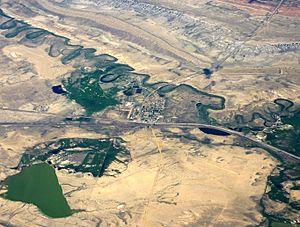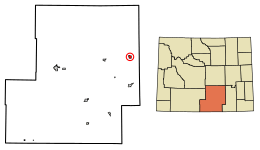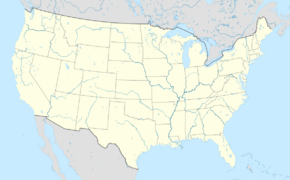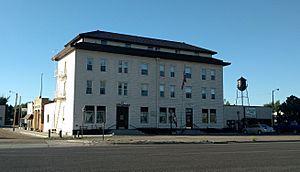Medicine Bow, Wyoming facts for kids
Quick facts for kids
Medicine Bow, Wyoming
|
|
|---|---|

Aerial view of Medicine Bow and surrounding area
|
|

Location of Medicine Bow in Carbon County, Wyoming
|
|
| Country | United States |
| State | Wyoming |
| County | Carbon |
| Area | |
| • Total | 3.46 sq mi (8.96 km2) |
| • Land | 3.46 sq mi (8.96 km2) |
| • Water | 0.00 sq mi (0.00 km2) |
| Elevation | 6,565 ft (2,001 m) |
| Population
(2010)
|
|
| • Total | 284 |
| • Estimate
(2019)
|
259 |
| • Density | 74.90/sq mi (28.92/km2) |
| Time zone | UTC-7 (Mountain (MST)) |
| • Summer (DST) | UTC-6 (MDT) |
| ZIP code |
82329
|
| Area code(s) | 307 |
| FIPS code | 56-51575 |
| GNIS feature ID | 1591446 |
Medicine Bow is a small town in Carbon County, Wyoming, United States. In 2010, about 284 people lived there. The town is named after the Medicine Bow River.
Contents
History of Medicine Bow
Medicine Bow started because of the first transcontinental railroad. This big railroad line was built through the area in 1868. A post office opened in Medicine Bow in 1869.
Dinosaur Discoveries
Around 1898, a famous dinosaur skeleton called Dippy was found near Medicine Bow. This was a type of Diplodocus dinosaur. In 1899, fossil hunters from big museums like the American Museum of Natural History and the Field Museum stayed in the town. They were looking for large dinosaur bones.
Medicine Bow was a good place for paleontologists (dinosaur scientists) to stop. It had a railroad, and it was close to hills with lots of dinosaur fossils. These fossils came from the Jurassic period, in a rock layer called the Morrison Formation. Many Diplodocus and Brontosaurus fossils were found nearby at Como Bluff.
Old West Challenges
In the past, the town faced some challenges with bandits. Famous outlaws like Butch Cassidy and his Wild Bunch committed the Wilcox Train Robbery not far from Medicine Bow.
The Virginian Hotel
The Virginian Hotel is a historic building in Medicine Bow. It was built in 1911 by August Grimm. People believe it was named after a famous book called The Virginian by Owen Wister. This book is set in and around Medicine Bow. The hotel was added to the National Register of Historic Places in 1978. This means it's an important historical site.
Lincoln Highway
In the 1910s, part of the Lincoln Highway went through Medicine Bow. The Lincoln Highway was one of the first roads that crossed the entire United States. Later, in 1970, Interstate 80 replaced this old highway route.
Geography and Location
Medicine Bow is located at 41°53′52″N 106°12′10″W / 41.89778°N 106.20278°W. The town covers an area of about 3.46 square miles (8.96 square kilometers), and all of it is land.
People of Medicine Bow
| Historical population | |||
|---|---|---|---|
| Census | Pop. | %± | |
| 1910 | 127 | — | |
| 1920 | 210 | 65.4% | |
| 1930 | 264 | 25.7% | |
| 1940 | 338 | 28.0% | |
| 1950 | 328 | −3.0% | |
| 1960 | 392 | 19.5% | |
| 1970 | 455 | 16.1% | |
| 1980 | 953 | 109.5% | |
| 1990 | 389 | −59.2% | |
| 2000 | 274 | −29.6% | |
| 2010 | 284 | 3.6% | |
| 2019 (est.) | 259 | −8.8% | |
| U.S. Decennial Census | |||
In 2010, there were 284 people living in Medicine Bow. There were 125 households and 81 families. Most of the people (95.1%) were White. About 6.7% of the population were Hispanic or Latino.
The average age of people in Medicine Bow was about 49 years old.
- 20.1% of residents were under 18.
- 25.4% were 65 or older.
- The town had slightly more males (53.5%) than females (46.5%).
Economy
In 2007, there were plans to build a large coal gasification plant near Medicine Bow. This plant would have turned coal into gas for energy. It was expected to start building in 2014. However, the project was later put on hold because the cost of oil became very low.
Education
Students in Medicine Bow attend public schools run by Carbon County School District Number 2.
- Younger students go to Medicine Bow Elementary School (grades K–6).
- Older students attend H.E.M. Junior/Senior High School (grades 7–12).
Medicine Bow also has a public library. It is part of the Carbon County Library System.
See also
 In Spanish: Medicine Bow (Wyoming) para niños
In Spanish: Medicine Bow (Wyoming) para niños




